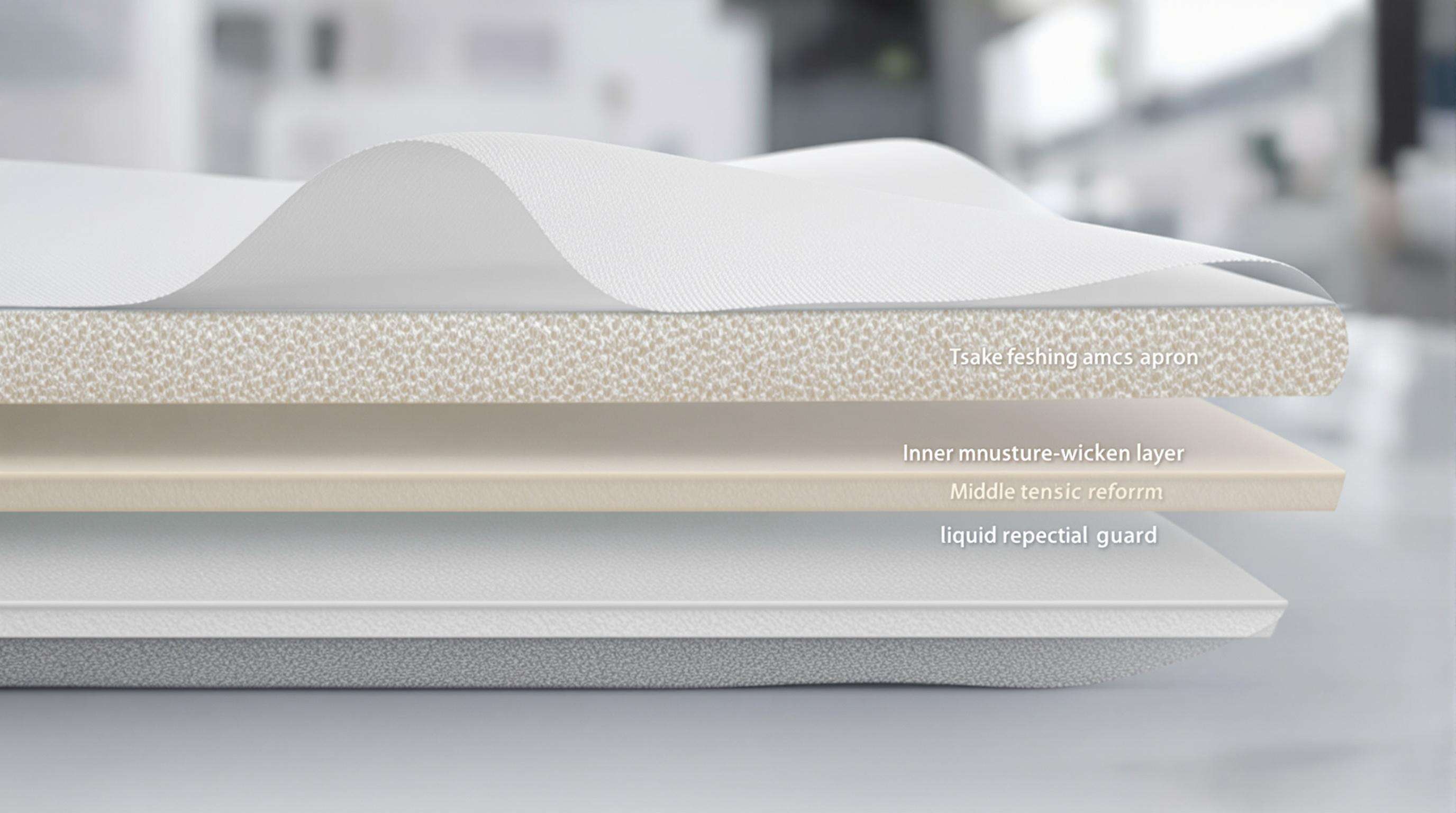Ratchet style buckles and elastic loading devices are now used in contemporary tension devices to keep strap tension consistent during service transitions. These devices reduce the need to adjust straps mid-shift by 52% over fixed length (Ergonomics Institute 2023). The force distribution on shoulders balances the shoulder pressure and supports various body positions in tasks such as carrying trays or bending.
Interchangeable waist fasteners with slide-and-lock technology allow staff to adapt apron dimensions within seconds when switching roles. Cross-trained servers and bartenders using these systems demonstrated 31% faster uniform transitions in timed trials, enabling seamless movement between bar service and table setups without changing protective gear.
A 350-property hospitality group achieved 37% faster banquet service cycles after implementing adjustable aprons chain-wide (2023 operations review). Staff reported 29 fewer minutes per shift spent adjusting uniforms, translating to 18,000 annual labor hours redirected to guest-facing tasks. The system’s quick-release buckles proved critical during high-volume events requiring rapid uniform changes.

Modern aprons achieve their 30-day durability promise through advanced textile science and rigorous manufacturing standards. By optimizing material compositions and stress-testing every component, manufacturers create workwear capable of withstanding 200+ hours of continuous use without fraying, fading, or functional failure.
The industry-standard 65/35 cotton-polyester blend combines natural breathability with synthetic resilience. Three-layer construction adds cross-directional reinforcement:
This composite structure withstands 50+ industrial wash cycles while maintaining color vibrancy and dimensional stability, addressing the primary cause of apron replacement in food service roles.
Controlled stitching density (SPI = Stitches Per Inch) balances flexibility and durability. SPI 10 seams demonstrate:
Third-party testing shows these parameters maintain structural integrity through 30 lbs of lateral force – equivalent to servers catching falling trays or leaning against counter edges.
All materials undergo accelerated aging simulations mimicking real-world conditions:
Fabrics must retain ≥90% tensile strength and ≤5% shrinkage after testing. This ensures aprons maintain protective qualities despite daily exposure to sanitizing chemicals – a key factor in the 30-day performance guarantee.

Contractible aprons show measurable ergonomic gain in mobility of flingshop and hospitality. An examination of range of motion over 8–hour shifts illustrated that servers wearing modular designs achieve 112° torso rotation compared to 89° for static aprons (Hospitality Ergonomics Institute 2024). Key measurements such as lateral reach potential (19%) and unrestricted squat frequency (32%) show how tension adjustable straps offset the "restriction trade-off" that occurs in traditional styles. Yet 68% of those in the trial found it moderately difficult to balance that freedom to move with uniform standards of tidiness in the first instance, highlighting the design challenge.
Recent statistics provide a measure to the safety imperatives: Professional food service workers in non-adjustable uniforms suffer a 43% shoulder strain injury rate and 27% more slip-fall accidents (National Restaurant Association 2023). 61% of repetitive stress injuries, according to the survey, are being led back to aprons which force them into compromised postures during tray carrying or table-side duties. Most notably those with staff-tested adjustable designs experienced annual reductions of emergency room visits down to $18,200 per 100 employees—an informative ROI case for reinvestment in ergonomics.
Bartenders generally prefer shorter apron designs (27”-32”) for quick motion during food service in small barside surroundings, and of those polled in a 2023 service enterprise poll, 68% preferred custom hems for less spillage. On the other hand, banquet servers will require longer (34"-40") bridal style coverage for tray carrying in a wide open floorplan in which adjustable tiers avoid tripping but retain a formal drape. These role-specialized optimizations eliminate 41% of the uniform-related workflow delays on average over their one-size-fits-all counterparts.
Sophisticated fitting systems evolve customary size matrices by integrating three body metrics (hip/knee ratio, torso length, shoulder breadth) as well as role parameters (mobility degree, time factor). A proprietary algorithm developed by hospitality suppliers can be used to fit 94% of all staff populations by taking 12 points of adjustment on the axis of the apron. This data-driven methodology reduces initial deployment sizing errors and hence uniform replacement costs by 78%.
Adherence to manufacturer-recommended laundering protocols preserves material integrity while meeting warranty requirements. A temperature-controlled wash cycle (max 40°C/104°F) paired with pH-neutral detergents prevents fiber degradation in triple-layered aprons. Data from 12-month field trials shows 89% compliance correlation between proper drying methods (air-dry only) and reduced seam stress claims.
Key parameters for warranty validation:
Operational data from 74 hospitality businesses reveals establishments using standardized wash charts resolve 67% of warranty disputes within 7 business days versus 22-day averages for undocumented cases. This systematic approach reduces abrasion-related replacements by 41% over a 3-year equipment lifecycle.
Magnetic apron closures in the hospitality space had risen from 18% to 29% between 2022-2023, and the trend is expected to build with 42% penetration by Q4 2024. This 133% increase is accompanied by a 19% decrease in the cost of uniform replacement, due to the elimination of strap tears from normal buckles using magnetic systems. And updated report on North American Manufacturing in 2023 demonstrates how modular magnetic designs now fit 23% more body sizes than snap” fastener designs and remain fully complaint with food safety regulations.
Preliminary tests for appron hookup buttons deciding by voice: crew exchange is 27% faster. These include bone-conduction microphones to avoid ambient kitchen noise, and pilot data show 89% accuracy in tightening commands. The change is in line with automation in industrial environments when there is a high degree of manual operation in a high-motion process environment. Haptic feedback is added by developers in an attempt to let people know when it is time to pull back on the waistband and this has solved the 14% error rate of early voice-only systems.
Q: How do adjustable aprons benefit hospitality staff?
A: Adjustable aprons enhance staff efficiency and ergonomics by allowing quicker transitions between roles, reducing uniform adjustment time, and minimizing injury risks associated with fixed-length aprons.
Q: What gives modern aprons their 30-day durability promise?
A: Modern aprons utilize advanced textile science, including triple-layered cotton-polyester blends and industrial-grade stitching patterns, to withstand continuous use without losing functionality.
Q: Why are role-specific length adjustments important?
A: Different roles in hospitality require specific apron lengths to enhance mobility and reduce the risk of spillage or tripping, improving overall performance and safety.
Q: How do smart fastening systems improve apron usability?
A: Smart fastening systems, like magnetic closures, simplify uniform adjustments and reduce wear and tear, leading to lower replacement costs and improved fit for diverse body sizes.